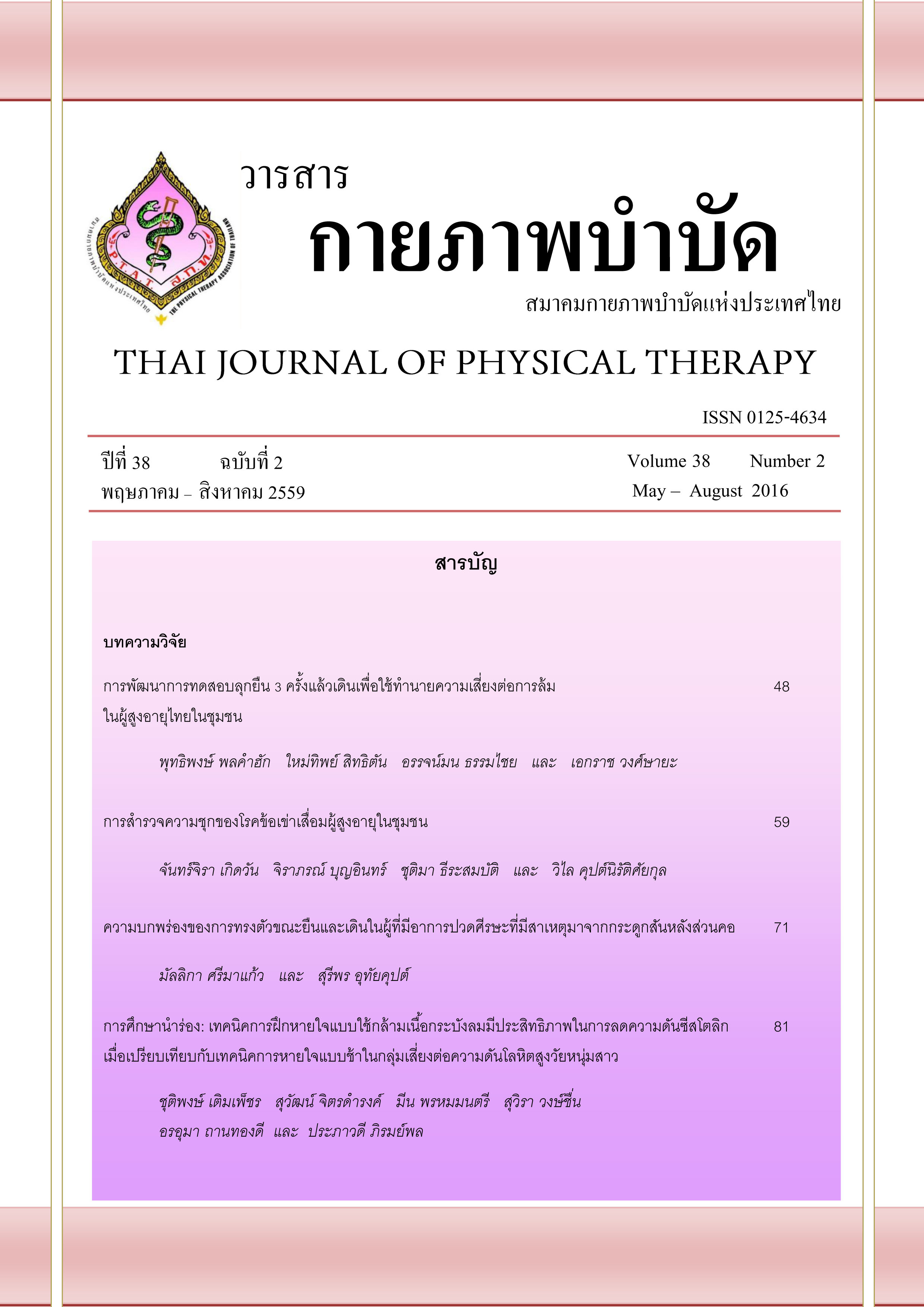การสำรวจความชุกของโรคข้อเข่าเสื่อมผู้สูงอายุในชุมชน
Main Article Content
บทคัดย่อ
ที่มาและความสำคัญ: โรคข้อเข่าเสื่อมนับเป็นปัญหาสำคัญของผู้สูงอายุที่รบกวนการดำเนินชีวิต และส่งผลต่อคุณภาพชีวิต
วัตถุประสงค์: ศึกษาค่าความชุกของโรคข้อเข่าเสื่อมและปัจจัยที่เกี่ยวข้อง
วิธีการ: ทำการศึกษาภาคตัดขวางในผู้สูงอายุในชุมชนตำบลอัมพวา จังหวัดสมุทรสงคราม โดยสำรวจค่าความชุกของโรคข้อเข่าเสื่อมด้วยการซักประวัติอาการของโรคข้อเข่าเสื่อมตามเกณฑ์การวินิจฉัยโรคของสมาคมโรคข้อแห่งสหรัฐอเมริกาดังนี้ คือ อาการปวดข้อเป็น ๆ หายๆ อาการมีเสียงดังขณะขยับข้อ รวมถึงมีอาการข้อฝืด/ตึง/ยึดในช่วงเช้าน้อยกว่า 30 นาที และประเมินดัชนีมวลกาย ค่ากำลังกล้ามเนื้อเหยียดเข่า วัดโดยเครื่อง dynamometer และประเมินอัตราเร็วในการเดินโดยคำนวณจากเวลาที่ใช้ในการเดินระยะทาง 6 เมตร นำข้อมูลที่ได้มาวิเคราะห์หาปัจจัยที่เกี่ยวข้องกับโรคข้อเข่าเสื่อม
ผลการศึกษา: พบผู้สูงอายุที่มีลักษณะตามเกณฑ์ของโรคข้อเข่าเสื่อมจำนวน 86 รายจากทั้งหมด 243 ราย คิดเป็นร้อยละ 35.4 (95%CI: ร้อยละ 29.6 - 41.6) เพศหญิงพบมากกว่าเพศชาย (ร้อยละ 39.8 และร้อยละ 22.6) และพบมากขึ้นตามอายุ (ร้อยละ 33.3 ในช่วงอายุ 60-69 ปี และร้อยละ 37.8 ในช่วงอายุมากกว่าหรือเท่ากับ 70 ปี) ส่วนปัจจัยที่เกี่ยวข้อง ได้แก่ เพศหญิงและผู้ที่มีดัชนีมวลกายมากกว่า 23.0 กิโลกรัมต่อตารางเมตร โดยมีค่า adjusted odds ratio เท่ากับ 2.13 (95% CI: 1.07, 4.24) และ 2.46 (95% CI : 1.37, 4.42) ตามลำดับ
สรุปการศึกษา: โรคข้อเข่าเสื่อมเป็นโรคที่พบบ่อยในกลุ่มผู้สูงอายุ โดยพบมากถึง 1 ใน 3 ของประชากรสูงวัยในชุมชน เพศหญิงและผู้ที่มีดัชนีมวลกายมากกว่าปกติ ควรได้รับการคัดกรองและให้คำแนะนำแต่เนิ่นๆ เพื่อป้องกันการเกิดโรคข้อเข่าเสื่อม
Article Details
เอกสารอ้างอิง
2. Neogi T, Zhang Y. Epidemiology of osteoarthritis. Rheum Dis Clin North Am. 2013; 39 (1): 1-19.
3. Kuptniratsaikul V, Tosayanonda O, Nilganuwong S, Thamalikitkul V. The epidemiology of osteoarthritis of the knee in elderly patients living an urban area of Bangkok. J Med Assoc Thai. 2002; 85 (2): 154-61.
4. Murphy L, Schwartz TA, Helmick CG, et al. Lifetime risk of symptomatic knee osteoarthritis. Arthritis Rheum. 2008; 59 (9): 1207-13.
5. Felson DT, Naimark A, Anderson J, Kazis L, Castelli W, Meenan RF. The prevalence of knee osteoarthritis in the elderly. The Framingham Osteoarthritis Study. Arthritis Rheum. 1987; 30 (8): 914-8.
6. Alnahdi AH, Zeni JA, Snyder-Mackler L. Muscle impairments in patients with knee osteoarthritis. Sports Health. 2012; 4 (4): 284-92.
7. Levinger P, Nagano H, Downie C, et al. Biomechanical balance response during induced falls under dual task conditions in people with knee osteoarthritis. Gait Posture. 2016;48:106-112.
8. Kim HS, Yun DH, Yoo SD, et al. Balance control and knee osteoarthritis severity. Ann Rehabil Med. 2011;35 (5):701-9.
9. Bindawas SM. Relationship between frequent knee pain, obesity, and gait speed in older adults: data from the Osteoarthritis Initiative. Clin Interv Aging. 2016;11:237-44.
10. Hayashi K, Kako M, Suzuki K, et al. Gait Speeds Associated with Anxiety Responses to Pain in Osteoarthritis Patients. Pain Med. 2015 Sep 9.
11. Sharma L, Song J, Dunlop D, et al. Varus and valgus alignment and incident and progressive knee osteoarthritis. Ann Rheum Dis. 2010; 69 (11): 1940-5.
12. Harvey WF, Yang M, Cooke TD, et al. Association of leg-length inequality with knee osteoarthritis: a cohort study. Ann Intern Med. 2010; 152 (5): 287-95.
13. Altman R, Asch E, Bloch D, et al. Development of criteria for the classification and reporting of osteoarthritis. Classification of osteoarthritis of the knee. Diagnostic and Therapeutic Criteria Committee of the American Rheumatism Association. Arthritis Rheum. 1986; 29 (8): 1039–49.
14. Lan Le-Ngoc, Jessica Janssen (2012). Validity and reliability of a hand-held dynamometer for dynamic muscle strength assessment. Rehabilitation Medicine. Chong Tae Kim, ed. InTech, DOI: 10.5772/37688. Available from: http://www.intechopen.com/books/rehabilitation-medicine/validity-and-reliability-of-a-hand-held-dynamometer-for-dynamic-muscle-strength-assessment
15. WHO Expert Consultation. Appropriate body-mass index for Asian populations and its implications for policy and intervention strategies. Lancet. 2004; 363 (9403): 157-63.
16. Assantachai P, Muangpaisan W, Intalapaporn S, Sitthichai K, Udompunturak S. Cut-off points of quadriceps strength, declines and relationships of sarcopenia-related variables among Thai community-dwelling older adults. Geriatr Gerontol Int. 2014; 14 Suppl 1:61-8.
17. Robinett CS, Vondran MA. Functional ambulation velocity and distance requirements in rural and urban communities. A clinical report. Phys Ther. 1988; 68 (9): 1371-3.
18. Cho HJ, Morey V, Kang JY, Kim KW, Kim TK. Prevalence and risk factors of spine, shoulder, hand, hip, and knee osteoarthritis in community-dwelling Koreans older than age 65 years. Clin Orthop Relat Res. 2015;473 (10):3307-14.
19. Lee S, Kim SJ. Prevalence of knee osteoarthritis, risk factors, and quality of life: The Fifth Korean National Health and Nutrition Examination Survey. Int J Rheum Dis 2015 Nov 18. doi: 10.1111/1756-185X.12795. [Epub ahead of print]
20. Andrianakos AA, Kontelis LK, Karamitsos DG, et al. Prevalence of symptomatic knee, hand, and hip osteoarthritis in Greece. The ESORDIG study. J Rheumatol. 2006; 33 (12): 2507-13.
21. Tang X, Wang S, Zhan S, et al. The prevalence of symptomatic knee osteoarthritis in China: Results from the China Health and Retirement Longitudinal Study. Arthritis Rheumatol. 2016;68 (3):648-53.
22. Liu Y, Zhang H, Liang N, Fan W, Li J, Huang Z, et al. Prevalence and associated factors of knee osteoarthritis in a rural Chinese adult population: an epidemiological survey. BMC Public Health. 2016;16 (1):94.
23. Al Saleh J, Sayed ME, Monsef N, Darwish E. The prevalence and the determinants of musculoskeletal diseases in Emiratis attending primary health care clinics in Dubai. Oman Med J. 2016;31 (2):117-23.
24. Davatchi F, Sandoughi M, Moghimi N, et al. Epidemiology of rheumatic diseases in Iran from analysis of four COPCORD studies. Int J Rheum Dis 2015 Dec 1. doi: 10.1111/1756-185X.12809. [Epub ahead of print]
25. Losina E, Weinstein AM, Reichmann WM, et al. Lifetime risk and age at diagnosis of symptomatic knee osteoarthritis in the US. Arthritis Care Res (Hoboken). 2013; 65 (5): 703-11.
26. Zhang Y, Xu L, Nevitt MC, et al. Comparison of the prevalence of knee osteoarthritis between the elderly Chinese population in Beijing and whites in the United States: The Beijing Osteoarthritis Study. Arthritis Rheum. 2001; 44 (9): 2065-71.
27. Zhang Y, Hunter DJ, Nevitt MC, et al. Association of squatting with increased prevalence of radiographic tibiofemoral knee osteoarthritis: the Beijing Osteoarthritis Study. Arthritis Rheum. 2004; 50 (4): 1187-92.
28. Blagojevic M, Jinks C, Jeffery A, Jordan KP. Risk factors for onset of osteoarthritis of the knee in older adults: a systematic review and meta-analysis. Osteoarthritis Cartilage. 2010; 18 (1): 24-33.
29. Plotnikoff R, Karunamuni N, Lytvyak E, et al. Osteoarthritis prevalence and modifiable factors: a population study. BMC Public Health. 2015;15:1195.
30. de Zwart AH, van der Esch M, Pijnappels MA, et al. Falls associated with muscle strength in patients with knee osteoarthritis and self-reported knee instability. J Rheumatol. 2015;42 (7):1218-23.
31. Tsonga T, Michalopoulou M, Malliou P, et al. Analyzing the history of falls in patients with severe knee osteoarthritis. Clin Orthop Surg. 2015;7 (4):449-56.
32. White DK, Niu J, Zhang Y. Is symptomatic knee osteoarthritis a risk factor for a trajectory of fast decline in gait speed? Results from a longitudinal cohort study. Arthritis Care Res (Hoboken). 2013;65 (2):187-94.


